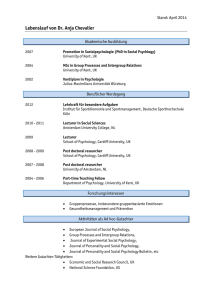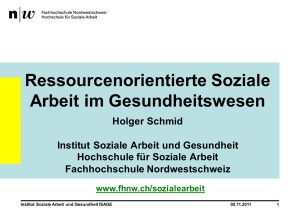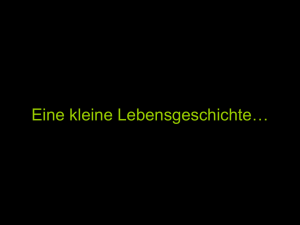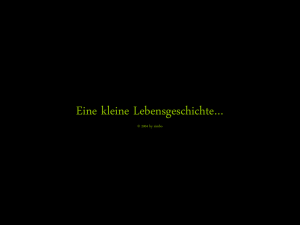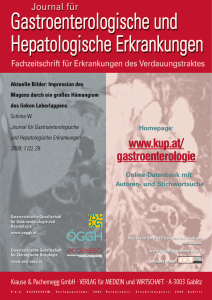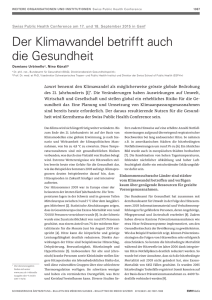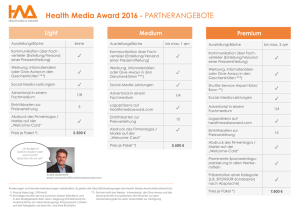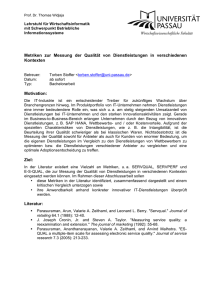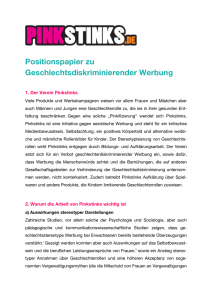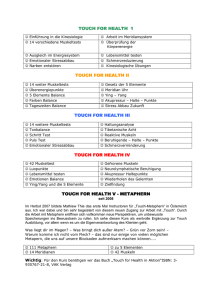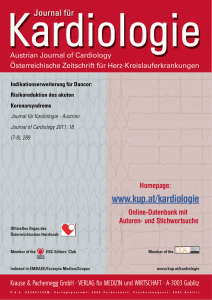Literatur zu den Beiträgen Psychologie der
Werbung
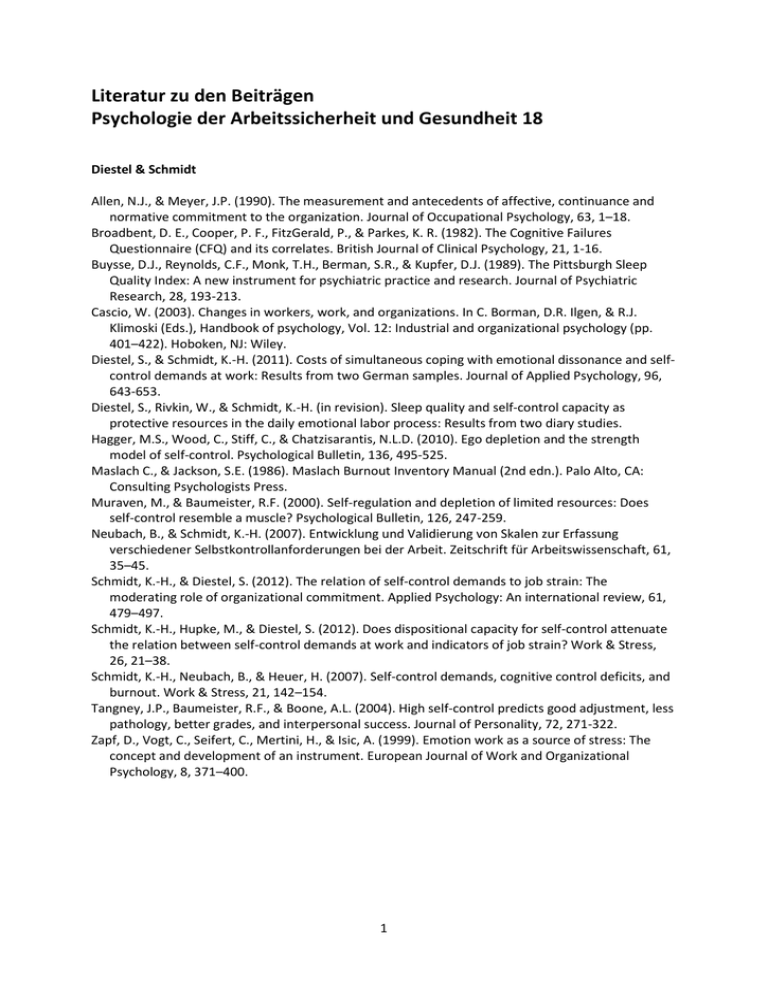
Literatur zu den Beiträgen Psychologie der Arbeitssicherheit und Gesundheit 18 Diestel & Schmidt Allen, N.J., & Meyer, J.P. (1990). The measurement and antecedents of affective, continuance and normative commitment to the organization. Journal of Occupational Psychology, 63, 1–18. Broadbent, D. E., Cooper, P. F., FitzGerald, P., & Parkes, K. R. (1982). The Cognitive Failures Questionnaire (CFQ) and its correlates. British Journal of Clinical Psychology, 21, 1-16. Buysse, D.J., Reynolds, C.F., Monk, T.H., Berman, S.R., & Kupfer, D.J. (1989). The Pittsburgh Sleep Quality Index: A new instrument for psychiatric practice and research. Journal of Psychiatric Research, 28, 193-213. Cascio, W. (2003). Changes in workers, work, and organizations. In C. Borman, D.R. Ilgen, & R.J. Klimoski (Eds.), Handbook of psychology, Vol. 12: Industrial and organizational psychology (pp. 401–422). Hoboken, NJ: Wiley. Diestel, S., & Schmidt, K.-H. (2011). Costs of simultaneous coping with emotional dissonance and selfcontrol demands at work: Results from two German samples. Journal of Applied Psychology, 96, 643-653. Diestel, S., Rivkin, W., & Schmidt, K.-H. (in revision). Sleep quality and self-control capacity as protective resources in the daily emotional labor process: Results from two diary studies. Hagger, M.S., Wood, C., Stiff, C., & Chatzisarantis, N.L.D. (2010). Ego depletion and the strength model of self-control. Psychological Bulletin, 136, 495-525. Maslach C., & Jackson, S.E. (1986). Maslach Burnout Inventory Manual (2nd edn.). Palo Alto, CA: Consulting Psychologists Press. Muraven, M., & Baumeister, R.F. (2000). Self-regulation and depletion of limited resources: Does self-control resemble a muscle? Psychological Bulletin, 126, 247-259. Neubach, B., & Schmidt, K.-H. (2007). Entwicklung und Validierung von Skalen zur Erfassung verschiedener Selbstkontrollanforderungen bei der Arbeit. Zeitschrift für Arbeitswissenschaft, 61, 35–45. Schmidt, K.-H., & Diestel, S. (2012). The relation of self-control demands to job strain: The moderating role of organizational commitment. Applied Psychology: An international review, 61, 479–497. Schmidt, K.-H., Hupke, M., & Diestel, S. (2012). Does dispositional capacity for self-control attenuate the relation between self-control demands at work and indicators of job strain? Work & Stress, 26, 21–38. Schmidt, K.-H., Neubach, B., & Heuer, H. (2007). Self-control demands, cognitive control deficits, and burnout. Work & Stress, 21, 142–154. Tangney, J.P., Baumeister, R.F., & Boone, A.L. (2004). High self-control predicts good adjustment, less pathology, better grades, and interpersonal success. Journal of Personality, 72, 271-322. Zapf, D., Vogt, C., Seifert, C., Mertini, H., & Isic, A. (1999). Emotion work as a source of stress: The concept and development of an instrument. European Journal of Work and Organizational Psychology, 8, 371–400. 1 Görg, Hammes & Wieland Bundesinstitut für Bau-, Stadt- und Raumforschung (2012). INKAR 2012 (Software). Bonn: Autor. Krone, A. (2010). Regionale Unterschiede im Unfallgeschehen – Teil 1 Arbeitsunfälle – ein Literaturüberblick. Dresden: Institut für Arbeit und Gesundheit der DGUV. Guhlemann, Georg & Katenkamp INDIGHO-Projektgruppe (2013): Demografischer Wandel im Gastgewerbe: Kompetenzentwicklung und Qualifizierung unter Bedingungen diskontinuierlicher Beschäftigung. Arbeitspapier 1. Dortmund: Sozialforschungsstelle der TU (Beiträge aus der Forschung, Band 187). Guhlemann, K. (2014). Jung, ausgebildet – weg. Wechselpläne und Fachkräftemangel in Zeiten des Demografischen Wandels im Gastgewerbe. Zeitschrift für Arbeitswissenschaft, 2/2014, i.E. Katenkamp, O.; Guhlemann, K.; Georg, A. (2014): Wechselmotive und Arbeitsbelastungen in unterschiedlichen Lebensphasen von Erwerbstätigten des Gastgewerbes. Dortmund: GfA-Press, i.E. Hacker Bundesanstalt für Arbeitsschutz und –medizin (Hrsg.) (2014). Gefährdungsbeurteilung psychischer Belastung. Erfahrungen und Empfehlungen. Berlin: Schmidt- Verlag DIN EN ISO 10075 (2000). Ergonomische Grundlagen bezüglich psychischer Arbeitsbelastung (ISO 10075: 1991; Deutsche Fassung EN ISO 10075: 2000). DIN EN ISO 6385 (2004). Grundsätze der Ergonomie für die Gestaltung von Arbeitssystemen. Berlin: Beuth. Richter, G. (2011). Toolbox Version 1.2. Instrumente zur Erfassung psychischer Belastungen. Dortmund/Berlin/Dresden: BAuA. Hauck Ariely, D. (2012), Wer denken will, muss fühlen. München: Knaur. ASD der BG BAU (o.J.), Gesundheitsberichte, www.bgbau.de Besser, R. (2004), Transfer: Damit Seminare Früchte tragen, Weinheim: Beltz BGI/GUV-I (2010), Arbeiten: entspannt, gemeinsam, besser – So geht’s mit Ideentreffen, Reihe: Gesund und Fit im Kleinbetrieb, Berlin: DGUV BZgA, Portal www.maennergesundheit.de FACT Sheet (2012), Zahlen, Daten, Fakten, St. Augustin: DGUV Farrelly, F. zitiert nach Höfner, N. (2013), Ernsthafte Beratung mit Humor?, www.provokativ.com Kirkeskov Jensen, L. (2010), Implementation of new working methods in the floor-laying trade: Longterm effects on knee load and knee complaints, American Journal of Industrial Medicin, Abstract Kölln, P. (2013), Männergesundheit, Bielefeld: Vortrag Schwarzer, R. & Jerusalem, M. (2002), Das Konzept der Selbstwirksamkeit, Zeitschrift für Pädagogik, Beiheft 44, S.28–53, Weinheim: beltz Zieschang. H. (2011), Kurzinformation zum Projekt „Horizontaler Berufsumstieg“, Dresden: IAG 2 Hessenmöller IAG Report 1/2011: Evaluation von Präventionskampagnen – Die Teile analysieren, das Ganze besser sehen: Effekte von Kampagnen der Unfallversicherung messen Horváth, Melzer, Buruck, Brom & Richter Alarcon, G. M. (2011). A meta-analysis of burnout with job demands, resources, and attitudes. Journal of Vocational Behavior, 79(2), 549-562. doi:10.1016/j.jvb.2011.03.007 Buruck, G., Debitz, U., & Rudolf, M. (2007). Screening Gesundes Arbeiten (SGA) - Erste Ergebnisse einer Pilotstudie. In P. G. Richter, R. Rau & S. Mühlpfordt (Eds.), Arbeit und Gesundheit. Zum aktuellen Stand in einem Forschungs- und Praxisfeld (pp. 73-94). Lengerich: Pabst. Buruck, G. & Richter, P. (2008). Psychische Belastungen: Weniger Befragung - mehr Beobachtung. Gute Arbeit - Gesundheitsschutz und Arbeitsgestaltung, 60, 30-32. Crawford, E. R., LePine, J. A., & Rich, B. L. (2010). Linking job demands and resources to employee engagement and burnout: a theoretical extension and meta-analytic test. J Appl Psychol, 95(5), 834-848. doi: 10.1037/a0019364 Debitz, U., Mühlpfordt, S., Buruck, G., Muzykorska, E., Lübbert, U., & Schmidt, H. (2010). Der Leitfaden zum Screening Gesundes Arbeiten (SGA). Physische und psychische Gefährdungen erkennen – gesünder arbeiten! (2 ed.). Dortmund: Bundesanstalt für Arbeitsschutz und Arbeitsmedizin. Demerouti, E., Bakker, A. B., Nachreiner, F., & Schaufeli, W. B. (2001). The job demands - resources model of burnout. J Appl Psychol, 86(3), 499-512. Gebele, N. (2010). Arbeit und Gesundheit: Zur objektiven Erfassung von Tätigkeitsmerkmalen nach dem Job Demand-Control Modell. (Dissertation), Philipps-Universität Marburg Retrieved from http://d-nb.info/100401855X/34 Jordan, P., Pohlandt, A., Hacker, W., & Richter, P. (1997). REBA - Rechnergestütztes Verfahren zur psychologischen Tätigkeitsbewertung. In K. Landau, H. Luczak & W. Laurig (Eds.), SoftwareWerkzeuge zur ergonomischen Arbeitsgestaltung.REFA-Fachbuchreihe Arbeitsgestaltung. Bad Urach: IFAO. Lee, R. T., & Ashforth, B. E. (1996). A meta-analytic examination of the correlates of the three dimensions of job burnout. J Appl Psychol, 81(2), 123-133. Podsakoff, P. M., MacKenzie, S. B., Lee, J. Y., & Podsakoff, N. P. (2003). Common method biases in behavioral research: a critical review of the literature and recommended remedies. J Appl Psychol, 88(5), 879-903. doi:10.1037/0021-9010.88.5.879 Rau, R. (2010). Befragung oder Beobachtung oder beides gemeinsam? – Welchen Instrumenten ist der Vorzug bei Untersuchungen zur psychischen Belastung und Beanspruchung zu geben? Zentralblatt Arbeitsmedizin, 60, 294-301. Schaufeli, W., & Salanova, M. (2014). Burnout, Boredom and Engagement in the Workplace. In M. C. W. Peeters, J. d. Jonge & T. W. Taris (Eds.), An Introduction to Contemporary Work Psychology. Wiley-Blackwell. Leiter (Eds.), Maslach Burnout Inventory Manual (Vol. 3). Palo Alto, CA: Consulting Psychologists Press. Khodaverdi & Eigenstetter Gather, C., Gerhard, U; Schroth, H. & Schürmann, L. (2005). Vergeben und Vergessen? Gebäudereinigung im Spannungsfeld zwischen kommunalen Diensten und Privatisierung. Verfügbar unter http://www.harriet-taylor-mill.de/pdfs/e_books/ GathCl_Vergeben.pdf [23.02.2014] 3 Goggins, R. (2007). Hazards of Cleaningn. Strategies for reducing exposures to ergonomic risk factors. Prfoessional Safety. Verfügbar unter https://www.onepetro.org/download/journal-paper/ASSE07-03-20?id=journal-paper%2FASSE-07-03-20 [23.02.2014] EU-OSHA – (2009a). The occupational safety and health of cleaning workers. Verfüg-bar unter: https://www.osha.europa.eu/en/publications/literature_reviews/ cleaning_workers_and_OSH [23.02.2014]. EU-OSHA (2009b). Preventing harm to cleaning workers. Verfügbar unter: http://osha.europa.eu/en/publications/reports/TEWE09006ENC [23.02.2014] Eigenstetter, M. & Küpper, C. (2012). Arbeitsbedingungen von Reinigungskräften im Krankenhaus – psychisch und physisch belastend, gefährlich für sich und andere. In Psychologie der Arbeitssicherheit und Gesundheit. In G. Athanassiou, S. Schreiber-Costa & O. Sträter (Hrsg.), Psychologie der Arbeitssicherheit und Gesundheit. Sichere und gute Arbeit erfolgreich gestalten Forschung und Umsetzung in die Praxis. 17. Workshop 2012 (S. 255-258). Kröning: Asanger. Kix, Siegrist & Siegrist Andrea H, Bültmann U, van Amelsvoort LG, Kant Y (2009) The incidence of anxiety and depression among employees--the role of psychosocial work characteristics. Depress Anxiety 6:1040-8. Bamberger SG, Vinding AL, Larsen A, Nielsen P, Fonager K, Nielsen RN, Ryom P, Omland O (2012): Impact of organisational change on mental health: a systematic review. Occup Environ Med. 2012 Aug;69(8):592-8. Epub 2012 Apr 27. Bhui KS, Dinos S, Stansfeld SA, White PD (2012): A synthesis of the evidence for managing stress at work: a review of the reviews reporting on anxiety, depression, and absenteeism. J Environ Public Health. 12;2012:515874. Epub 2012 Feb 14. Greenberg J, Cropanzano R (eds) (2001) Advances in organizational justice. Stanford: Stanford University Press. Karasek RA, Theorell T (1990) Health work. New York: Basic Books. Kivimäki M, Ferrie JE, Marmot M (2010) Workplace and mental well-being: the Whitehall II study. Unpublished manuscript, University College, London. Martin A, Sanderson K, Cocker F (2009) Meta-analysis of the effects of health promotion intervention in the workplace on depression and anxiety symptoms. Scand J Work Environ Health 35: 7-18. Melchior M, Caspi A, Milne BJ, Danese A, Poulton R, Moffitt TE (2007): Work stress precipitates depression and anxiety in young, working women and men.Psychol Med. Aug;37(8):1119-29. . Epub 2007 Apr 4. Nieuwenhuijsen K, Bültmann U, Neumeyer-Gromen A et al. (2009) Interventions to improve occupational health in depressed people (Review).The Cochrane Collaboration. Wiley Issue 1. Nieuwenhuijsen K., Bruinvels D, Frings-Dresen M. (2010) Psychosocial work environment and stressrelated disorders, a systematic review. Occup Med (Lond). 2010 Jun;60(4):277-86. Ndjaboué R, Brisson C, Vézina M (2012): Organisational justice and mental health: a systematic review of prospective studies. Occup Environ Med, pub online van Oostrom SH, Driessen MT, de Vet HC et al. (2009): Workplace interventions for preventing work disability. Cochrane Database Syst Rev. 15 Pomaki G, Franche RL, Murray E, Khushrushahi N, Lampinen TM (2012): Workplace-based work disability prevention interventions for workers with common mental health conditions: a review of the literature. J Occup Rehabil. 22:182-95. Rugulies R, Aust B, Madsen IE, Burr H, Siegrist J, Bültmann U (2012): Adverse psychosocial working conditions and risk of severe depressive symptoms. Do effects differ by occupational grade? Eur J Public Health. Ruotsalainen J, Serra C, Marine A, Verbeek J (2008): Systematic review of interventions for reducing occupational stress in health care workers. Scand J Work Environ Health. 34:169-78. 4 Siegrist J (1996) Adverse health effects of high effort/low reward conditions. J Occup Health Psychol 1: 27-41. Smith PM, Bielecky A (2012): The impact of changes in job strain and its components on the risk of depression. Am J Public Health. 102:352-8. Epub 2011 Dec 15. Wittchen HU, Jacobi F, Rehm J et al (2011): The size and burden of mental disorders and other disorders of the brain in Europe 2010. Eur Neuropsychopharmacol. 21:655-79. Wittchen HU, Jacobi F, Mack S et al (2012): Was sind die häufigsten psychischen Störungen in Deutschland? Erste Ergebnisse der „Zusatzuntersuchung psychische Gesundheit“ (DEGS-MHS). Bundesgesundheitsblatt 9-10. Kretschmer, Griefahn & Schmidt Aan het Rot, M., Moskowitz, D. S. & Young, S. N (2008). Exposure to bright light is associated with positive social interaction and good mood over short time periods: A naturalistic study in mildly seasonal people. Journal of Psychiatric Research, 42, 311–319. Badia, P., Myers, B., Boecker, M. & Culpepper, J. (1991). Bright light effects on body temperature, alertness, EEG and behaviour. Physiology & Behavior, 50, 583–588. Baron, R. M. & Kenny, D. A. (1986). The moderator-mediator variable distinction in social psychological research: conceptual, strategic, and statistical considerations. Journal of Personality and Social Psychology, 51(6), 1173–1182. Costa, G. (2005). Some considerations about aging, shift work and work ability. International Congress Series, 1280, 67–72. Gunzelmann, G., Gluck, K. A., Moore, L. R. & Dinges, D. F. (2012). Diminished access to declarative knowledge with sleep deprivation. Cognitive Systems Research, 13, 1–11. Kretschmer V, Griefahn B, Schmidt K-H (2011) Bright light and night work: effects on selective and divided attention in elderly persons. Lighting Research and Technology, 43, 473–486. Kretschmer, V., Schmidt, K.-H. & Griefahn, B. (2013). Bright light effects on cognitive performance in elderly persons working simulated night shifts: Psychological well-being as a mediator? International Archives of Occupational and Environmental Health, 86(8), 901–914. Kretschmer, V., Schmidt, K.-H., Griefahn, B. (2012). Bright light effects on working memory, concentration and sustained attention of elderly night shift workers. Lighting Research and Technology, 44(3), 316–333. Kutas G., Kwak Y., Bodrogi P., Park, D. S., Lee, S. D., Choh, H. K. & Kim, C. Y. (2008). Luminance contrast and chromaticity contrast preference on the colour display for young and elderly users. Displays, 29, 297–307. Santhi, N., Aeschbach, D., Horowitz, T. S. & Czeisler, C. A. (2008). The impact of sleep timing and bright light exposure on attentional impairment during night work. Journal of Biological Rhythms, 23(4), 341–352. Tsunoda, M., Endo, T., Hashimoto, S., Honma, S. & Honma K.-I. (2001). Effects of light and sleep stages on heart rate variability in humans. Psychiatry and Clinical Neurosciences, 55, 285–286. Kreutzer & Trimpop Antonovsky, A. (1979). Health, stress and coping: New perspectives on mental and physical wellbeeing. The Jossey-Bass social and behavioral science series. San Francisco, London: Jossey-Bass. Arnold, K. A., Turner, N., Barling, J., Kelloway, E. K., & McKee, M. C. (2007). Transformational leadership and psychological well-being: The mediating role of meaningful work. Journal of Occupational Health Psychology, 12(3), 193–203. 5 Badura, B., Hehlmann, T., & Walter, U. (2010). Betriebliche Gesundheitspolitik: Der Weg zur gesunden Organisation (2., vollst. überarb. Aufl). Berlin [u.a.]: Springer. Bundesanstalt für Arbeitsschutz und Arbeitsmedizin. (2012). Sicherheit und Gesundheit bei der Arbeit 2011: Unfallverhütungsbericht Arbeit. DAK-Gesundheit. (2012). DAK-Gesundheitsreport. Eriksson, I., Undén, A.-L., & Elofsson, S. (2001). Self-rated health. Comparisons between three different measures. Results from a population study. International Journal of Epidemiology, 2001(30), 326–333. Expertenkommission ‚Die Zukunft einer zeitgemäßen betrieblichen Gesundheitspolitik’. (2004). Zukunftsfähige betriebliche Gesundheitspolitik. Gräser, S. (2003). Hochschule und Gesundheit : Salutogenese am Arbeitsplatz Universität. Lengerich [u.a.]: Pabst Science Publ. Gregersen, S., Kuhnert, S., Zimber, A., & Nienhaus, A. (2011). Führungsverhalten und Gesundheit Zum Stand der Forschung. Das Gesundheitswesen, 73(01), 3–12. doi:10.1055/s-0029-1246180. Hayes, A. F. (2013). Introduction to mediation: A regression-based approach. Methodology in the social sciences. New York: Guilford Publications. Holstad, T. J., Rigotti, T., & Otto, K. (2013). Prozedurale Fairness als Mediator zwischen transformationaler Führung und psychischer Beanspruchung am Arbeitsplatz: Eine Mehrebenenstudie. Zeitschrift für Arbeits- und Organisationspsychologie A&O, 57(4), 163–176. doi:10.1026/0932-4089/a000120 Matyssek, A. K. (2012). Führung und Gesundheit: Ein praktischer Ratgeber zur Förderung der psychosozialen Gesundheit im Betrieb (3. Aufl). Do care! Norderstedt: Books on Demand. Vincent, S. (2011). Gesundheits- und Entwicklungsförderliches Führungsverhalten: Ein Analyseinstrument. In B. Badura, A. Ducki, H. Schröder, J. Klose, & K. Macco (Eds.), FehlzeitenReport 2011 (pp. 49–60). Berlin, Heidelberg: Springer Berlin Heidelberg. WHO. (Version 1998). WHO (Fünf) - Fragebogen zum Wohlbefinden. Pietrzyk, Stab, Fuchs & Schiefen Lohmann-Haislah, A. (2012). Stressreport Deutschland 2012. Psychische Anforderungen, Ressourcen und Befinden. Dortmund: BAuA Nationale Arbeitsschutzkonferenz (2012). Leitlinie Beratung und Überwachung bei psychischer Belastung am Arbeitsplatz. Berlin: Nationale Arbeitsschutzkonferenz. Mohr, G., Rigotti, T. & Müller, A. (2007). Irritations-Skala zur Erfassung arbeitsbezogener Beanspruchungsfolgen (IS). Göttingen: Hogrefe. Poßin & Ahrens Bass, B. M. and Avolio, B., Improving Organizational Effectiveness Through Transformational Leadership, Thousand Oaks et. al., 1994 Franke, F. & Felfe, J. How does transformational leadership impact employees’ psychological strain? Examining differentiated effects and the moderating role of commitment. Leadership, 7, 295 – 316, 2011 Lazarus, Richard S.: Stress and Emotion. A new Synthesis. Free Association Books, London 1999 Meyer, J. P., Stanley, David J., Herscovitch, L., and Topolnytsky, L.: Affective, Continuance, and Normative Commitment to the Organization: A Meta-analysis of Antecedents, Correlates, and Consequences. Journal of Vocational Behavior 61, 20–52, 2002 Wissenschaftliches Institut der AOK (WIdO), Fehlzeiten Report, 2012 6 Rau Buysse, D.J.; Reynolds, C.F.; Monk, T.H., Berman, S.R.; Kupfer, D.J. (1989). The Pittsburgh Sleep Quality Index: A new instrument for psychiatric practice and research. Psychiatry Research, 28: 193‐ 2 1 3 . Fragebogen in deutscher Übersetzung und Normwerten: http://www.charite.de/dgsm/dgsm/fachinformationen_frageboegen_psqi.php. Cropley, M., & Millward Purvis, L. J. (2003). Job strain and rumination about work issues during leisure time: A diary study. European Journal of Work and Organizational Psychology, 12, 195 – 207. Doi, Y. (2005). An epidemiologic review on occupational sleep research among Japanese workers. Industrial Health, 43, 3–10 Nakanishi, N., Yoshida, H., Nagano, K., Kawashimo, H., Nakamura, K. & Tatara, K. (2001). Long working hours and risk for hypertension in Japanese male white collar workers. Journal of Epidemiology and Community Health, 55, 316‐322. Nishikitani, M., Nakao, M., Karita, K., Nomura, K. & Yano, E. (2005). Influence of Overtime Work, Sleep Duration, and Perceived Job Characteristics on the Physical and Mental Status of Software Engineers. Industrial Health , 43, 623–629. Pickering, T. G. (1993). Applications of ambulatory blood pressure monitoring in behavioral medicine. Annals of Behavioral Medicine, 15, 26‐32. Plath, H‐E.& Richter, P. 1984: Ermüdung‐Monotonie‐Sättigung‐Streß. Verfahren zur skalierten Erfassung erlebter Beanspruchungsfolgen. Göttingen: Hogrefe. Rau, R. & Triemer, A. (2004). Overtime work affects blood pressure and mood during work, leisure and night time. Social Indicators Research, 51‐73. Rau, R., Morling, K., Gebele, N. & Rösler, U. (2010). Untersuchung arbeitsbedingter Ursachen für das Auftreten von depressiven Störungen. (FB 1865), Bremerhaven: Wirtschaftsverlag NW. Richter, P.& Hacker, W. (1998). Belastung und Beanspruchung. Heidelberg: Asanger. Richter, P., Rudolf, M. & Schmidt, C. F. (1996). Fragebogen zur Analyse belastungsrelevanten Anforderungsbewältigung (FABA). Frankfurt: Swets. Schuller, K., Rösler, U. & Rau, R.(2014). Self‐reported job characteristics and negative spillover from work to private life as mediators between expert‐rated job characteristics and vital exhaustion. European Journal of Work and Organizational Psychology, 23, 177‐189. Sonnentag, S. & Bayer, U.‐V. (2005). Switching off mentally: Predictors and consequences of psychological detachment from work during off‐job time. Journal of Occupational Health Psychology, 10, 393 – 414. Theorell, T., Ahlberg‐Hulten, G., Jodko, M., Sigala, F. & Torre, B. (1993). Influence of job strain and emotion on blood pressure in female hospital personnel during workhours. Scandinavian Journal of Work and Environmental Health, 19, 313‐318. van Egeren (1992). The relationship between job strain and blood pressure at work, at home, and during sleep. Psychosomatic Medicine, 54, 337‐343. Riebe & Ruttke DGUV (2013). Prävention wirksam gestalten – Erkenntnisse aus der Sifa-Langzeitstudie (DGUV Report III). Berlin. DGUV; IAG (Hrsg.) (2009). Qualität in der Prävention – Wirksamkeit und Wirtschaftlichkeit der Präventionsdienstleistungen der gewerblichen Berufsgenossenschaften. Dresden. Trimpop, R. et al. (2012). Sifa-Langzeitstudie. Tätigkeit und Wirksamkeit von Fachkräften für Arbeitssicherheit. Abschlussbericht verfügbar unter: http://sifa-langzeitstudie.de/images/SifaLangzeitstudie_Abschlussbericht_ISBN.pdf 7 Ruttke, Brachwitz & Trimpop Erke und Gstalter (1985). Verkehrskonflikttechnik. Handbuch für die Durchführung und Auswertung von Erhebungen. Bundesanstalt für Straßenwesen (Hrsg.). Bremerhaven. Wirtschaftsverlag NW. Trimpop, R.M. (1999). Organisationaler Wandel im Arbeits-, Verkehrs-, Gesundheitsund Umweltschutz. Göttingen: Nord-West Verlag. Trimpop und Gericke (2010).Verkehrssicherheit in die Gefährdungsbeurteilung implementieren. DVRSchriftenreihe "Risiko Raus". 119 – 147 Trimpop Trimpop, R. & Danne, A. (2012). Professional Driving: Evaluation eines ganzheitlichen Ansatzes zur Erhöhung der betrieblichen Verkehrssicherheit. In:Athanassiou, G., Schreiber-Costa, S. Sträter, O. Hrsg.) (2012). Psychologie der Arbeitssicher- heit und Gesundheit: 17. Workshop. Heidelberg: Asanger. S.303-306. Drucker, P.F. (1954) The Practice of Management. Harper & Row, New York Porter, M. E. (1999): Wettbewerbsvorteile, Campus:Frankfurt/Main Rüegg-Stürm, J. (2003): Das neue St. Galler Management-Modell : Grundkategorieneiner integrierten Managementlehre : der HSG-Ansatz. Bern : Haupt. Wieland & Hammes Farrenkopf, F. & Mertens, H. (2014). Projekt zur Förderung der psychischen Gesundheit am Arbeitsplatz. In: M. Eigenstetter, T. Kunz & R. Portuné (Hrsg.) (2014). Psychologie der Arbeitssicher-heit und Gesundheit. Psychologie der Gesunden Arbeit. 18. Workshop 2014 in Dresden. Kröning: Asanger Verlag. Hammes, M. & Wieland, R. (2012). Screening-Instrument zu Beanspruchung während der Arbeit. In G. Athanassiou, S. Schreiber-Costa & O. Sträter (Hrsg.), Psychologie der Arbeitssicherheit und Gesundheit - Sichere und gute Arbeit erfolgreich gestalten - Forschung und Umsetzung in die Praxis (S. 331-334). Kröning: Asanger. Nachreiner, F. & Schütte, M. (2005). DIN EN ISO 10075-3 – eine Ergonomie-Norm mit Anforderungen an Verfahren zur Messung psychischer Belastung, Beanspruchung und ihrer Folgen. Zeitschrift für Arbeits- und Organisationspsychologie, 49, 154-160. Nachreiner, F. (2008). Erfassung psychischer Belastung und Rückwirkung auf die Arbeitsgestaltung – Grenzen der Aussagekraft subjektiver Belastungsanalysen. Angewandte Wissenschaft, 198, 34-55. Wieland, R. & Hammes, M. (2010). BARMER GEK Gesundheitsreport 2010 Teil 2 - Ergebnisse der Internetstudie zur Gesundheitskompetenz. Wuppertal: BARMER GEK. Auch online verfügbar. Wieland, R. & Hammes, M. (2014). Wuppertaler Screening Instrument Psychische Beanspruchung (WSIB). Beanspruchungsbilanz und Kontrollerleben als Indikatoren für gesunde Arbeit. Eingereicht: Journal Psychologie des Alltagshandelns. Wieland, R. (2004). Arbeitsgestaltung, Selbstregulationskompetenz und berufliche Kompetenzentwicklung. In: B. Wiese (Hrsg.) Individuelle Steuerung beruflicher Entwicklung. Kernkompetenzen in der modernen Arbeitswelt, (S. 169 – 196). Frankfurt am Main: Campus. Wieland, R. (2006). Eigenschaftswörterliste zur Erfassung von Emotionen und Beanspruchung während der Arbeit (EEB). Kompetenzzentrum für Fortbildung und Arbeitsgestaltung (KomFor): Bergische Universität Wuppertal. Wieland, R. (2013). Status-Bericht: Psychische Gesundheit in der betrieblichen Gesundheitsförderung - eine arbeitspsychologische Perspektive. In H. Nold & G. Wenninger (Hrsg.), Rückengesundheit und psychische Gesundheit (S. 103-128). Kröning: Asanger. 8 Wieland, R. 2002. Verfahren zur Ermittlung psychischer Belastung nach DIN EN ISO 10075, Teil 3 – eine Betrachtung aus arbeitspsychologischer Perspektive Erweiterte Fassung eines Vortrags auf dem Workshop „Psychische Belastung“, St. Augustin, 2001. Kompetenzzentrum für Fortbildung und Arbeitsgestaltung (KomFor): Bergische Universität Wuppertal. Wolf, Oberkötter Bethge M., Radoschewski F.M. (2011): Adverse effects of effort-reward imbalance on work ability: Longitudinal findings from the German Sociomedical Panel of Employees. In: International Journal of Public Health, DOI 10.1007/s00038-011-0304-2 De Jonge J., Dormann C., van den Tooren M. (2007): The demand-induced strain compensation model. Renewed theoretical considerations and empirical evidence. In: Näsvall K., Hellgren J., Swerke M. (Hg.): The individual in the changing working life. Cambridge: Cambridge University Press, 67-87 Dietscher C., Nowak P., Stidl T. (2004): Gesundheitsförderndes Führen in Spitälern und Pflegeeinrichtungen. Wien: ÖGTPGF, LBIMGS Enterprise for Health (Hg.) (2005): Psychosoziale Gesundheit und Führung. Gütersloh und Essen: Bertelsmann Stiftung und BKK Bundesverband Ilmarinen J., Tempel J. (2002): Arbeitsfähigkeit 2010: Was können wir tun, damit Sie gesund bleiben? Düsseldorf und Hamburg: DGB Bildungswerk e.V. und VSA-Verlag Kistler E., Fuchs T. (2004): Was ist Gute Arbeit? Anforderungen aus der Sicht von Erwerbstätigen. Eine repräsentative Befragung im Rahmen der Initiative Neue Qualität der Arbeit (INQA). Zwischenbericht. Stadtbergen: INIFES – Internationales Institut für Empirische Sozialökonomie, Vincent S. (2011): Gesundheits- und entwicklungsförderndes Führungsverhalten: Ein Analyseinstrument. In: Badura B., Ducki A., Schröder H., Klose J., Macco K. (Hg.): Fehlzeiten-Report 2011. Führung und Gesundheit. Zahlen, Daten, Analysen aus allen Branchen der Wirtschaft. Berlin, Heidelberg, New York: Springer, 49-60 Zimber Cascio, W. (2003). Changes in workers, work, and organizations. In C. Borman, D.R. Ilgen & R.J. Klimoski (Eds.), Handbook of Psychology (Vol. 12, pp. 401-422). Hoboken, NJ: Wiley & Sons. Gonzales, V.M. & Mark, G. (2005). Managing currents of work: multi-tasking among multiple collaborations. In H. Gellersen et al. (Eds.), ECSCW 2005: Proceedings of the Ninth European Conference on Computer-Supported Cooperative Work, 18-22 September 2005, Paris, (pp.143– 162). Amsterdam: Springer. Hockey, G. R. J. (1997). Compensatory control in the regulation of human performance under stress and high workload: A cognitive-energetical framework. Biological Psychology, 45, 73-93. König, C. J., Oberacher, L.& Kleinmann, M. (2010). Personal and situational determinants of multitasking at work. Journal of Personnel Psychology, 9 (2), 99-103. Lohmann-Haislah, A. (2012). Stressreport Deutschland 2012 - Psychische Anforderungen, Ressourcen und Befinden. Dortmund/Berlin/Dresden: Bundesanstalt für Arbeitsschutz und Arbeitsmedizin (BAuA). Salvucci, D. D. (2005). A multitasking general executive for compound continuos tasks. Cognitive Science, 29, 457-492. Ulich, E. (2005). Arbeitspsychologie. Stuttgart: Schäffer-Poeschel. Zimber, A. (2010). Multitasking am Arbeitsplatz - Herausforderung oder Gesundheitsrisiko? Forschungsstand und Ergebnisse einer explorativen Studie. Arbeit, 10 (4), 283-288. 9 Zimber, A. & Rigotti, T. (im Druck). Multitasking und zunehmende Komplexität: Anforderungen der modernen Arbeitswelt verstehen, bewerten und bewältigen. Reihe „Managementpsychologie“. Göttingen: Hogrefe. Zimolong, sowie Elke, Zimolong & Nold Günther, G., Lehnhoff, B., Elke,G. & Zimolong, B. (2012).Evaluation eines Verhaltensprogramms zur Prävention chronischer Rückenschmerzen im Verwaltungskontext.. In Georgios Athanassiou, Sabine Costa-Schreiber, Oliver Sträter (Hrsg.) Psychologie der Arbeitssicherheit und Gesundheit. 17. Workshop Gesundheit und Arbeitssicherheit 2012, Kröning, Asanger Verlag. Henschke, N., Maher, C.G., Refshauge, K.M., Herbert, R.D., Cumming, R.G., Bleasel, J., et al., (2008). Prognosis in patients with recent onset low back pain in Australian primary care: inception cohort study. Br Med J. , 337:a171. doi: 10.1136/bmj.a171 Henschke, N., Ostelo, R.W.J.G., van Tulder, M.W., Vlaeyen, J.W.S., Morley, S., Assendelft, W.J.J. & Main, C.J (2010). Behavioural treatment for chronic low-back pain. Cochrane Database of Systematic Reviews Art. No.: CD002014(7). Lehnhoff, B. (2011), Rückhalt für den Alltag – in 7 Schritten: Entwicklung, Erprobung und erste Evaluationsschritte eines Verhaltensprogramms zur Prävention von chronischen Rückenschmerzen. Dissertation Ruhr-Universität Bochum. Fakultät für Psychologie. Raspe, Heiner. (2012). Rückenschmerzen. Berlin: Gesundheitsberichterstat-tung des Bundes, Robert Koch-Institut Shaw, W.S., Main, C.J., & Johnston, V. (2011). Addressing occupational factors in the management of low back pain: implications for physical thera-pist practice. Physical Therapy 91(5), 777-789. van Middelkoop, M., Rubinstein, S. L. , Kuijpers, T., Verhagen, A., Ostelo, R., Koes, B. & van Tulder, M. (2011). A systematic review on the effectiveness of physical and rehabilitation interventions for chronic non-specific low back pain. European Spine Journal, 20(1), 19-39. doi: 10.1007/s00586010-1518-3 10
